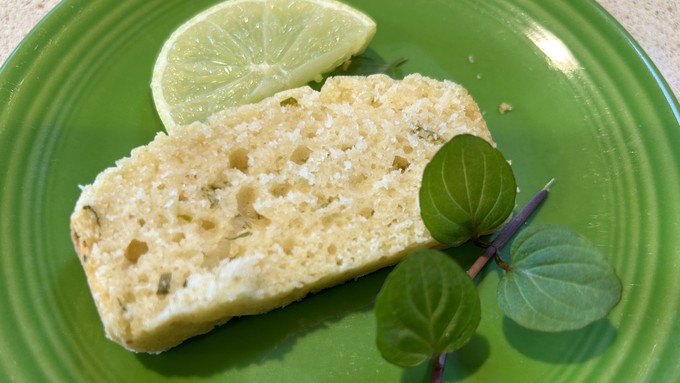
Recipe: Zest and herb combination also works in muffins

Lime-mint bread is spectacular with coffee or tea. The mint sprig on the plate is from a lime mint; it also makes excellent tea itself. Kathy Morrison
This is an off year for my orange tree, but my lime tree has made up for the citrus gap. The fruit is ripening quickly, so I'm trying to use it up. (Can't give it away, unfortunately, thanks to the Oriental fruit fly quarantine.)

I hit on putting lime and mint together in a quick bread, and found an easy Betty Crocker recipe to adapt. I used a mint actually called lime mint, but just about any mint would work -- spearmint probably better than peppermint. Sub lemon for the lime if you want, or try 1 teaspoon orange zest in place of half the lime zest.
I baked my tea bread in two disposable aluminum pans, because I planned to take it to a potluck. The two smaller loaves take less time to bake and are easier to cut for serving. But use whatever good bread pan you have available.
This recipe also makes spectacular muffins, baked for about 20-25 minutes.
Lime-mint tea bread
Serves 16
Ingredients:
1-3/4 cups unbleached all-purpose flour
3/4 cup granulated sugar, organic if possible
2 teaspoons baking powder
1/4 teaspoon salt
1 egg
1 cup buttermilk
1/4 cup neutral vegetable oil
2 teaspoons grated lime zest, from 1 large or 2 small limes
3 tablespoons fresh lime juice, divided
Handful of fresh mint leaves, finely chopped (about 2 teaspoons)
1 tablespoon plus 1 teaspoon granulated or confectioners' sugar, for brushing
Instructions:
Heat oven to 350 degrees. Grease and lightly flour a 9-by-5-inch bread pan or two small disposable pans.
In a medium bowl, whisk together the flour, 3/4 cup granulated sugar, baking powder and salt.
In another bowl or large measuring cup, combine the egg, buttermilk, oil, lime zest, 1 tablespoon of the juice, and all the mint.
Stir the liquid mixture into the flour mixture until moistened. Some lumps may be visible, but that's OK -- quick bread should not be overmixed.
Bake until the top starts to brown and a toothpick inserted in the center comes out clean, 50 to 60 minutes for a standard loaf pan, 40-45 minutes for the smaller pans.
Meanwhile, combine the remaining 2 tablespoons of juice with the remaining granulated sugar or the confectioner's sugar, whichever you're using. (It will be a thin mixture, not like cake glaze.) When the bread comes out of the oven, brush the mixture over the top. Let cool 10 minutes on a rack, then remove from pan(s) and allow to cool thoroughly before cutting and serving.
Comments
0 comments have been posted.Sacramento Digs Gardening to your inbox.
Sites We Like
Garden Checklist for week of May 12
Get your gardening chores and irrigation done early in the day before temperatures rise.
* Plant, plant, plant! It’s prime planting season in the Sacramento area. Time to set out those tomato transplants along with peppers and eggplants. Pinch off any flowers on new transplants to make them concentrate on establishing roots instead of setting premature fruit.
* Direct-seed melons, cucumbers, summer squash, corn, radishes, pumpkins and annual herbs such as basil.
* Harvest cabbage, lettuce, peas and green onions. This heat will cause leafy greens and onions to flower; pick them before they bolt.
* In the flower garden, direct-seed sunflowers, cosmos, salvia, zinnias, marigolds, celosia and asters.
* Plant dahlia tubers. Other perennials to set out include verbena, coreopsis, coneflower and astilbe.
* Transplant petunias, marigolds and perennial flowers such as astilbe, columbine, coneflowers, coreopsis, dahlias, rudbeckia and verbena.
* Keep an eye out for slugs, snails, earwigs and aphids that want to dine on tender new growth.
* Feed summer bloomers with a balanced fertilizer.
* For continued bloom, cut off spent flowers on roses as well as other flowering plants.
* Got fruit trees? If you haven't already done so, thin orchard fruit such as apples, peaches, pears, pluots and plums before they grow too heavy, breaking branches or even splitting the tree. Leave the largest fruit on the branch, culling the smaller ones, and allow for 5 to 6 inches (or a hand's worth) between each fruit.
* Thin grape bunches, again leaving about 6 inches between them. For the remaining bunches, prune off the "tail" end, about the bottom third of the bunch, so that the plant's energy is concentrated in the fruit closest to the branch.
* As spring-flowering shrubs finish blooming, give them a little pruning to shape them, removing old and dead wood. Lightly trim azaleas, fuchsias and marguerites for bushier plants.
* Add mulch to the garden to help keep that precious water from evaporating. Mulch also cuts down on weeds. But don’t let it mound around the stems or trunks of trees or shrubs. Leave about a 6-inch to 1-foot circle to avoid crown rot or other problems.